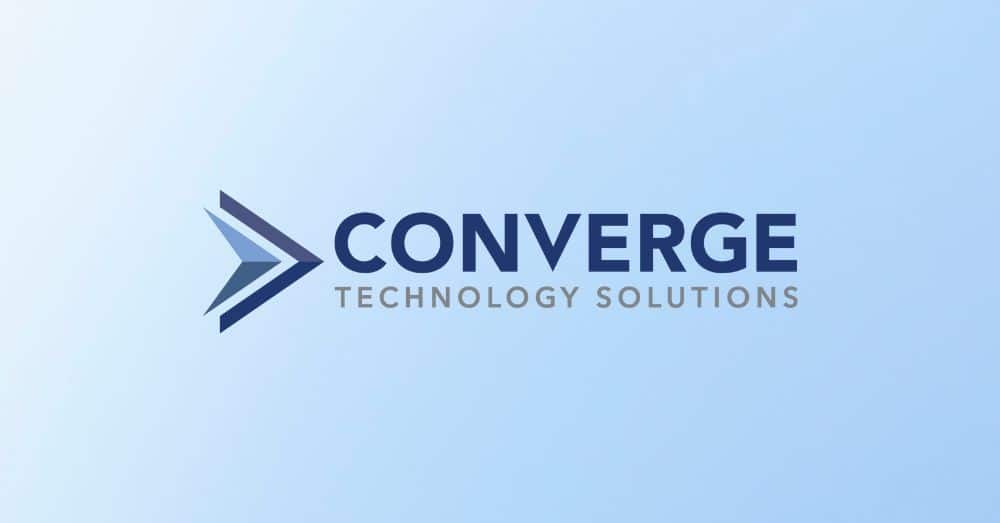FOR IMMEDIATE RELEASE
Read French Canadian Version Here
May 10, 2022 – TORONTO, ONTARIO, CANADA and GATINEAU, QUÉBEC, CANADA – Converge Technology Solutions Corp. (“Converge” or “the Company”) (TSX:CTS) (FSE:0ZB) (OTCQX:CTSDF) is pleased to provide its financial results for the three month period ended March 31, 2022. All figures are in Canadian dollars unless otherwise stated.
For the three-month period ended March 31, 2022 (“Q1-2022”) Converge reports the following financial highlights:
- Q1-2022 net revenue increased 77% over the same quarter last year (“Q1-2021”) to $550.0 million
- Organic gross revenue growth[1] for Q1-2022 compared to last year was approximately 7.2%
- Q1-2022 gross profit increased 60.8% over last year to $ 109 million
- Adjusted EBITDA1 increased 58% to $29.6 million from $ 18.8 million last year and LTM Adjusted EBITDA1 increased 53.4% to $104.9 million from $68.4 million last year.
- For Q1-2022, the Company generated Adjusted Free Cashflow and Adjusted Free Cash Flow Conversion1 of $24.2 million and 82%, respectively
- Reported Adjusted EPS1 of $0.10 per share for Q1-2022 increasing by 25% from $0.08 per share in Q1-2021 and LTM Adjusted EPS1 of $0.38 per share, increasing by 27% from $0.30 per share in Q1-2021 LTM.
- Bookings backlog2 increased to approximately $472 million in Q1-2022 compared to $350 million in Q4 2021 subsequent to clearing $250 million worth of backlog during the quarter
- Achieved 111 net new logos in Q1-2022 compared to 95 net new logos in Q4-2021
Q1-2022 Business Highlights & Subsequent to Quarter
- Acquired approximately $398.7 million of LTM gross revenue and $29.4 million EBITDA through five acquisitions year-to-date including Paragon Development Systems, Inc. (PDS); Visucom GmbH; Creative Breakthroughs, Inc. (CBI); and Interdynamix Systems (IDX)
- Converge subsidiary Portage Cybertech completed the acquisition of 1CRM
- Expanded company’s senior leadership team through appointment of John Teltsch as Chief Revenue Officer and announced Richard Lecoutre to join Converge as Global Chief Financial Officer in Q3-2022.
- Converge named to CRN®Managed Service Provider (MSP) 500 list in the Elite 150 Category & 2022 CRN® Tech Elite 250 List and placed eighth on 2022 CDN Top 100 Solution Providers
“I want to congratulate our team on a record quarter showing outstanding year-over-year growth across key financial metrics,” said Shaun Maine, CEO. “Demand was extremely strong, as we generated approximately $575 million in product orders from customers throughout Q1, combined with an improvement in the supply chain, where $250 million of the $350 million backlog that we reported in Q4 was invoiced in Q1. With now over $472 million in product backlog entering Q2, accounting for 24% of Converge’s total 2021 gross revenue, Converge is poised for strong double-digit organic growth as the supply chain normalizes.”
Conference Call Details:
Date: Wednesday, May 11, 2022
Time: 8:00 AM Eastern Time
Participant Dial-in Details:
Webcast Link – https://edge.media-server.com/mmc/p/58mbfnht
Toll Free – North America (+1) 888 708 0720
Toll Free – International (929) 517 9011
Germany – 0800 181 5287
United Kingdom – 0800 028 8438
Conference ID: 5877301
Recording Playback Numbers:
Toll Free – (855) 859 2056
Alternative Number – (404) 537 3406
Conference ID: 5877301
Expiry Date: May 18th, 2022
A live audio webcast accompanied by presentation slides and archive of the conference call will be available by visiting the Company’s website at https://convergetp.com/investor-relations/. Please connect at least 15 minutes prior to the conference call to ensure time for any software download that may be needed to hear the webcast.
About Converge
Converge Technology Solutions Corp. is a software-enabled IT & Cloud Solutions provider focused on delivering industry-leading solutions and services. Converge’s global solution approach delivers advanced analytics, application modernization, cloud, cybersecurity, digital infrastructure, and digital workplace offerings to clients across various industries. The Company supports these solutions with advisory, implementation, and managed services expertise across all major IT vendors in the marketplace. This multi-faceted approach enables Converge to address the unique business and technology requirements for all clients in the public and private sectors. For more information, visit convergetp.com.
For further information contact:
Converge Technology Solutions Corp.
Email: [email protected]
Phone: 416-360-1495
Summary of Consolidated Statements of Financial Position (expressed in thousands of Canadian dollars
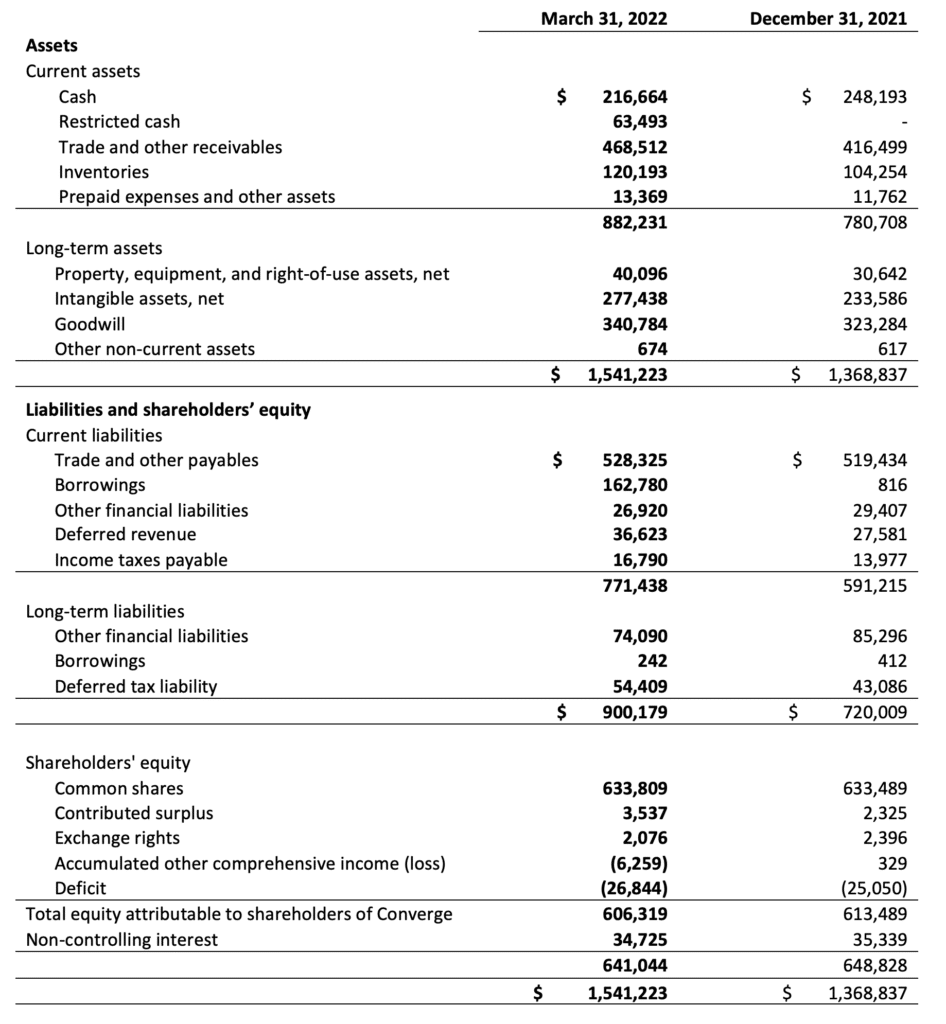
Summary of Consolidated Statements of Income (Loss) and Comprehensive Income (Loss)
(expressed in thousands of Canadian dollars)
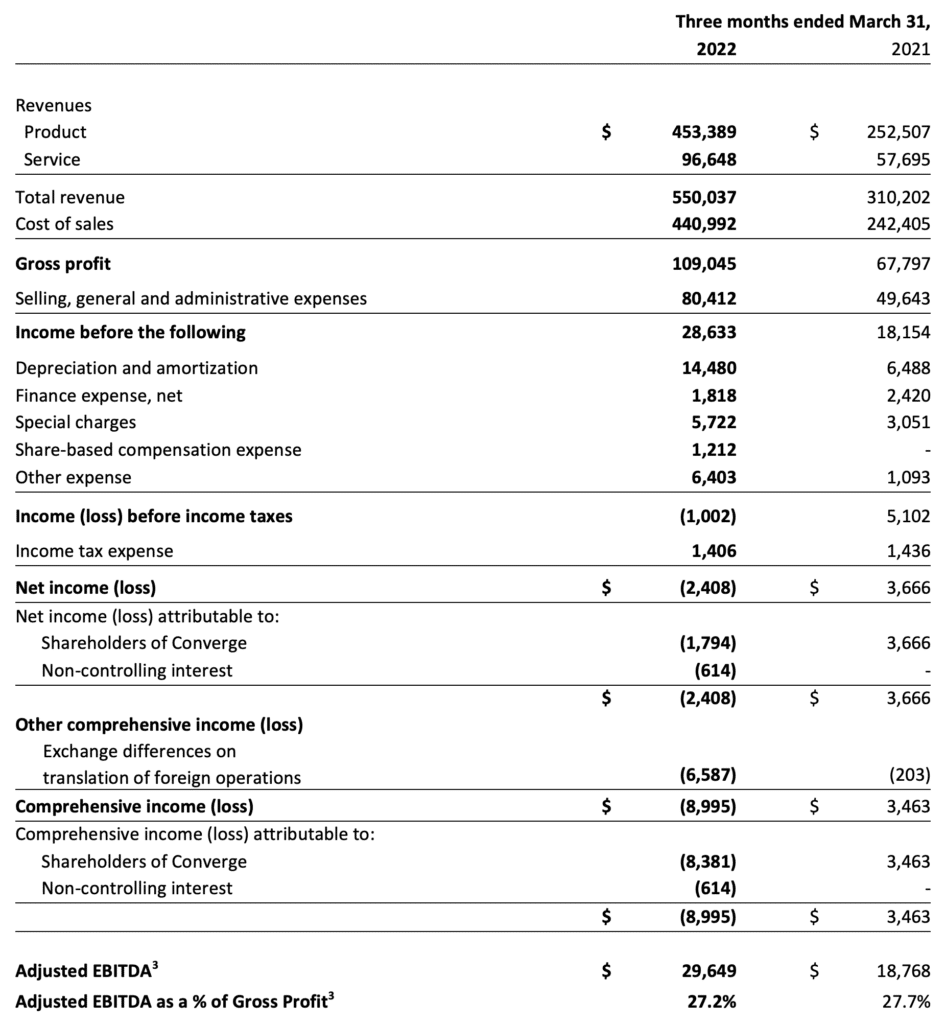
Summary of Consolidated Statements of Cash Flows
(expressed in thousands of Canadian dollars)
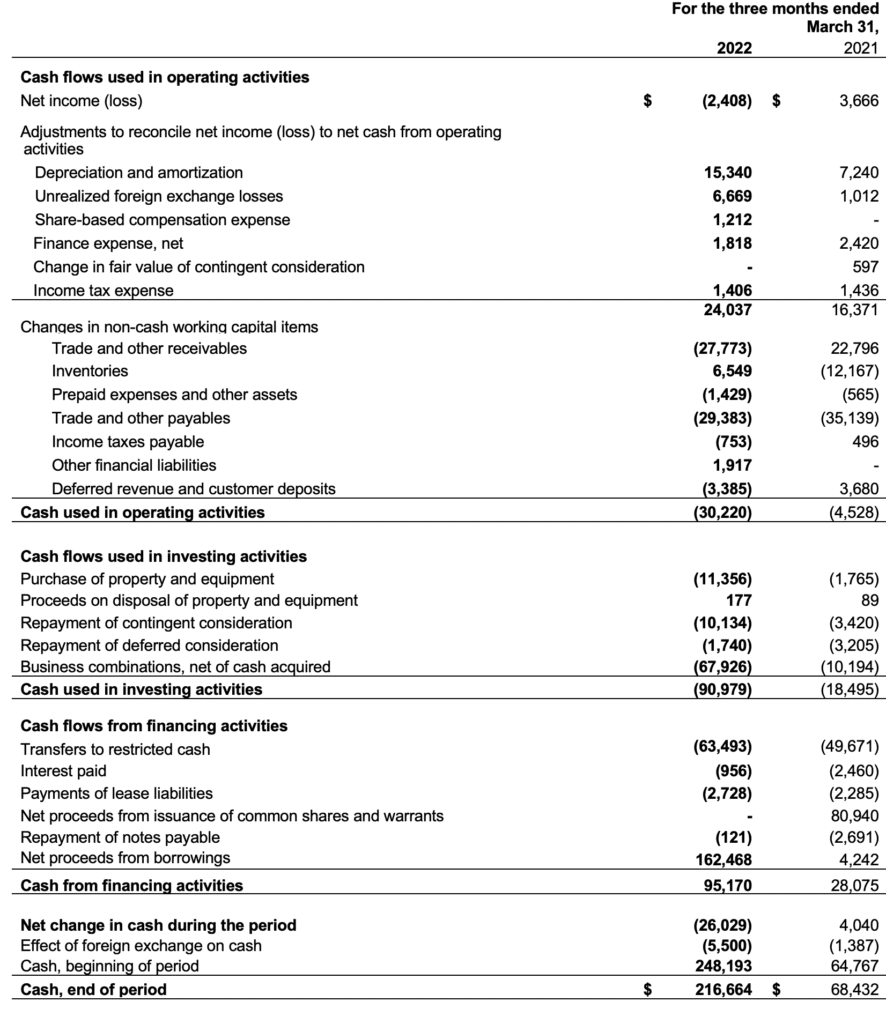
Non-IFRS Financial Measures
This news release refers to certain performance indicators including “Adjusted earnings before interest, taxes, depreciation and amortization (Adjusted EBITDA)”, “Adjusted Free Cash Flow”, “Adjusted Free Cash Flow Conversion”, “Adjusted Net Income (Loss)” and “Adjusted Earnings per Share”, “Gross Revenue”, and “Organic Growth” which are not recognized under IFRS and do not have any standardized meaning prescribed by IFRS. Converge’s method of calculating such non-IFRS measures and ratios may differ from methods used by other companies and therefore may not be comparable to similar measures presented by other companies. Management believes that these measures are useful to most shareholders, creditors, and other stakeholders in analyzing the Company’s operating results, and can highlight trends in its core business that may not otherwise be apparent when relying solely on IFRS financial measures. The Company also believes that securities analysts, investors and other interested parties frequently use non-IFRS measures in the evaluation of issuers.
Management also uses non-IFRS measures and ratios in order to facilitate operating performance comparisons from period to period, prepare annual operating budgets and assess the ability to meet capital expenditure and working capital requirements. These non-IFRS financial measures and ratios are furnished to provide additional information and should not be considered in isolation or as an alternative to the consolidated income (loss) or any other measure of performance under IFRS. Investors are encouraged to review the Company’s financial statements and disclosures in their entirety and are cautioned not to put undue reliance on non-IFRS measures and ratios and view them in conjunction with the most comparable IFRS financial measures.
Adjusted EBITDA
Adjusted EBITDA represents net income (loss) or income adjusted to exclude amortization, depreciation, interest expense and finance costs, foreign exchange gains and losses, share-based compensation expense, income tax expense, and special charges. Special charges consist primarily of restructuring related expenses for employee terminations, lease terminations, and restructuring of acquired companies, as well as certain legal fees or provisions related to acquired companies. From time to time, it may also include adjustments in the fair value of contingent consideration, and other such non-recurring costs related to restructuring, financing, and acquisitions.
Adjusted EBITDA is not a recognized, defined, or standardized measure under IFRS. The Company’s definition of Adjusted EBITDA will likely differ from that used by other companies and therefore comparability may be limited. Adjusted EBITDA should not be considered a substitute for or in isolation from measures prepared in accordance with IFRS.
The Company has reconciled Adjusted EBITDA to the most comparable IFRS financial measure as follows:

Adjusted Free Cash Flow and Adjusted Free Cash Flow Conversion
The Company calculates Adjusted Free Cash Flow as Adjusted EBITDA less: (i) recurring capital expenditures (“Recurring Capex”) and (ii) lease payments relating to the IFRS 16 lease liability (“IFRS 16 Lease Liability”). Management defines Recurring Capex as the actual capital expenditures which are required to maintain the Company’s existing and ongoing operations in its normal course of business. Recurring Capex excludes one-time expenditures to support growth initiatives that the Company categorizes as non-recurring in nature. Adjusted Free Cash Flow is a useful measure that allows the Company to primarily identify how much pre-tax cash is available for continued investment in the business and for the Company’s growth by acquisition strategy.
Management also believes that Adjusted EBITDA is a good proxy for cash generation and as such, Adjusted Free Cash Flow Conversion is a useful metric that demonstrates that the rate at which the Company can convert Adjusted EBITDA to cash.
The following table provides a calculation for Adjusted Cash Flow and Adjusted Cash Flow Conversion for the Q1-2022 and Q1-2021:

The Company believes that Adjusted EBITDA as a % of Gross Profit is a useful measure of the Company’s operating efficiency and profitability. This is calculated by dividing Adjusted EBITDA by gross profit.
Adjusted Net Income (Loss) and Adjusted Earnings per Share (“EPS”)
Adjusted Net Income (Loss) represents net income (loss) adjusted to exclude special charges, amortization of acquired intangible assets, and share-based compensation. The Company believes that Adjusted Net Income (Loss) is a more useful measure than net income (loss) as it excludes the impact of one-time, non-cash and/or non-recurring items that are not reflective of Converge’s underlying business performance. Adjusted EPS is calculated by dividing Adjusted Net Income (Loss) by the total weighted average shares outstanding on a basic and diluted basis.
The Company has provided a reconciliation to the most comparable IFRS financial measure as follows:
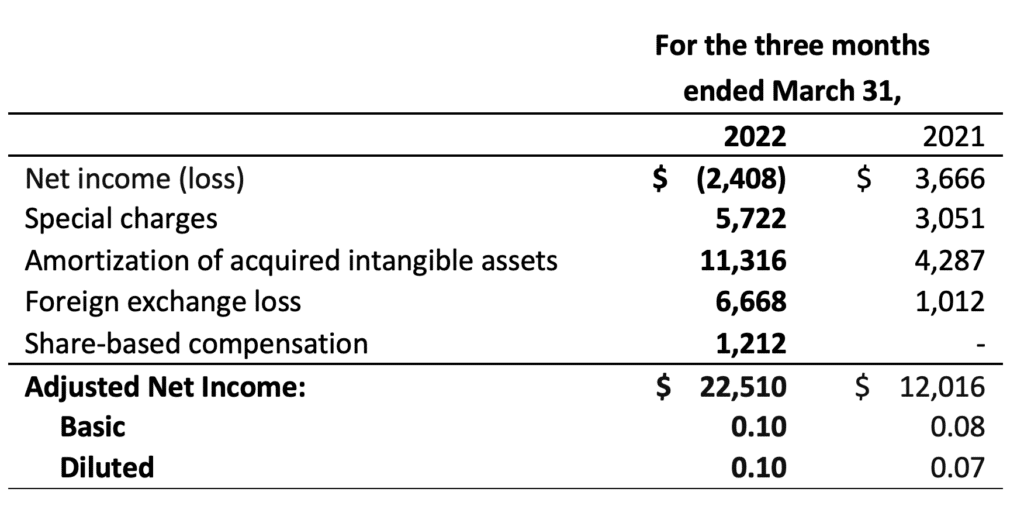
Gross revenue, which is a non-IFRS measurement, reflects the gross amount billed to customers, adjusted for amounts deferred or accrued. The Company believes gross revenue is a useful alternative financial metric to net revenue, the IFRS measure, as it better reflects volume fluctuations as compared to net revenue. Under the applicable IFRS 15 ‘principal vs agent’ guidance, the principal records revenue on a gross basis and the agent records commission on a net basis. In transactions where Converge is acting as an agent between the customer and the vendor, net revenue is calculated by reducing gross revenue by the cost of sale amount. Gross revenue for organic growth is calculated as i) the actual gross revenue for companies owned by Converge for at least three months that is included in the Company’s financial results for the year then ended, plus ii) for those acquisitions that occurred after January 1 and that have been under Converge ownership for at least three months, the pro forma gross revenue contribution had they been owned for the full fiscal year.
The Company has provided a reconciliation of gross revenue to net revenue, which is the most comparable IFRS financial measure, as follows:
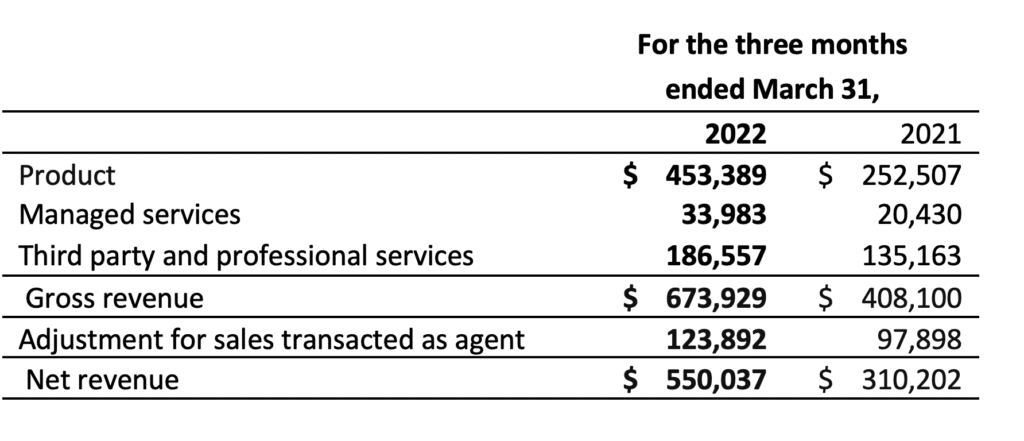
The following table calculates organic growth for Q1-2022:
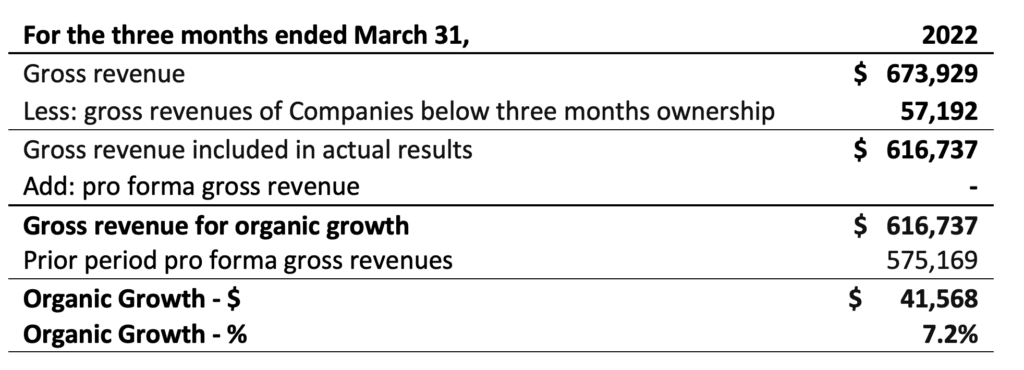
Forward-Looking Information
This press release contains certain “forward-looking information” and “forward-looking statements” (collectively, “forward-looking statements”) within the meaning of applicable Canadian securities legislation regarding Converge and its business. Any statement that involves discussions with respect to predictions, expectations, beliefs, plans, projections, objectives, assumptions, future events or performance (often but not always using phrases such as “expects”, or “does not expect”, “is expected” “anticipates” or “does not anticipate”, “plans”, “budget”, “scheduled”, “forecasts”. “estimates”, “believes” or intends” or variations of such words and phrases or stating that certain actions, events or results “may” or “could, “would”, “might” or “will” be taken to occur or be achieved) are not statements of historical fact and may be forward-looking statements. Forward-looking statements are necessarily based upon a number of estimates and assumptions that, while the Company considers reasonable, are subject to known and unknown risks, uncertainties, and other factors which may cause the actual results and future events to differ materially from those expressed or implied by such forward-looking statements. Except as required by law, Converge assumes no obligation to update the forward-looking statements of beliefs, opinions, projections, or other factors, should they change. The reader is cautioned not to place undue reliance on forward-looking statements.
For a detailed description of the risks and uncertainties facing the Company and its business and affairs, readers should refer to the Company’s filings available on SEDAR under the Company’s profile at www.sedar.com including its most recent Annual Information Form, its Management Discussion and Analysis and its Annual and Quarterly Financial Statements.
[1] This is a Non-IFRS measure (including non-IFRS ratio) and not a recognized, defined or a standardized measure under IFRS. See the Non-IFRS Financial Measures section of this news release for definitions, uses and a reconciliation of historical non-IFRS financial measures to the most directly comparable IFRS financial measures.
2 Bookings backlog is calculated as purchase orders received from customers not yet delivered at the end of the fiscal period.

